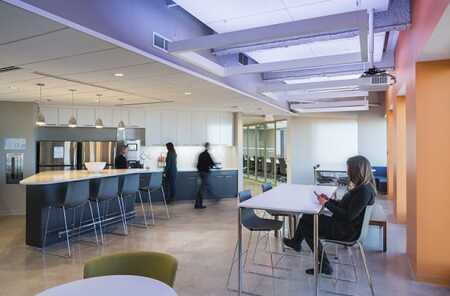One of the most difficult challenges for those seeking to adopt emerging technologies in commercial real estate is justifying the cost of implementing such measures. A recent ULI event in Boston highlighted the benefits of the evolving standards on health and wellness by five industry practitioners.
In July, ULI released The Business Case for Healthy Buildings: Insights from Early Adopters, which makes a case forphysical design and healthy practices of workplace environments having a positive impact on a company’s bottom line. The report, produced through the Institute’s Building Healthy Places Initiative, defines healthy buildings, outlines the certification programs, provides research data from recent health and wellness impact studies, and profiles early adopters of healthy building and workplace design and management practices.
“There’s been an amazing group of studies that have come together over the last ten years that have proven that there is a significant and material impact on health outcomes, employee retention, and productivity when you have a focus on a healthy work environment,” said Billy Grayson, executive director of the ULI Center for Sustainability and Economic Performance. Grayson spoke at a recent event hosted at the office of global engineering and design firm Arup, one of the firms profiled in the report. “Out of this broad range of studies, it was determined that employees are less likely to get sick, less likely to quit, easier to hire, more likely to be happier with their jobs, and can also be more productive because of a healthy office.”
The program featured a brief overview of the evolution of the $134 billion global wellness real estate industry by Grayson, followed by an in-depth presentation and tour of the 16,000-square-foot (1,100 sq m) office in downtown Boston by Arup associate Rebecca Hatchadorian, the project’s healthy building certification lead, and Brian Swett, Arup’s director of cities and sustainable real estate.
The five early adopters profiled for the report—Arup, CBRE (two offices), Hollywood Proper Residences, and Genentech—collected data on costs and benefits for over a year, and each reported positive results. In all cases, the report states, “the long-term financial impact of these benefits significantly outweighed the cost of pursuing a healthy-building certification [which can range from $0.50 to $5.00 per square foot for the various certifications.]”
“The response that we’ve gotten from staff in terms of increased productivity and general satisfaction, and how it supports the way they want to work, is an absolutely dramatic improvement in our new space,” said Arup’s Hatchadorian. “While we’re still trying to find the right metrics that measure that productivity component, with such dramatic responses, it definitely has some real quantifiable productivity impacts.”
Arup relocated from its Cambridge, Massachusetts, office to downtown Boston, with the intent of creating a work environment that would incorporate best practice health and wellness design and principles. The new office design prioritized workspace along the perimeter, allowing employees access to daylight and views, and Arup designed a circadian lighting system to replicate the daylight cycle. Active-design principles created flexible seating and standing arrangements to encourage movement around the space, including motorized sit/stand desks, and healthy and sustainable building materials were used wherever possible. New air ventilation and water filtration systems were installed, the catering was updated—with less healthy items eliminated—and a weekly fresh fruit delivery was added. The efforts earned the firm top certifications from WELL (Gold), Fitwel (three-star rating), and the Leadership in Energy and Environmental Design (LEED) Platinum Interior Design and Construction (ID+C): Commercial Interiors v4 certification.
Arup’s strategy was twofold. In addition to creating an optimal workspace for its employees, the firm wanted to fully explore the rating systems to better advise their own clients. “We wanted to walk the talk and test this on ourselves to make sure we know what we’re doing and not use our clients as guinea pigs,” said Swett. “We went in with our eyes open and did pre- and post-occupancy surveying on our own employees, both quantitative and qualitative, and now we can talk about how the space has impacted how we do business.”
According to the report, Arup estimates that WELL certification added a 0.5 percent premium to the project, which the firm thought would be recouped financially with at least a 0.5 percent improvement in productivity. Fitwel cost $6,500 for certification, while meeting LEED criteria amounted to a premium of 2 to 3 percent of development costs.
The report concludes that the evidence for a strong business case and value proposition is expected to grow as the market for and supply of health-promoting buildings and workspaces increase, and as real estate leaders gain experience designing, developing, leasing, and managing these projects. “It’s amazing to see the transformation that’s happened within the industry around how important and relevant it is to architects and real estate developers to focus on health as they’re thinking about how to develop their projects,” said Grayson.
Fitwel focuses on a dozen wellness health factors, including outdoor spaces, stairwells, interior environmental quality, water supply and cafeterias/vending machines, and requires re-certification every three years to ensure continued adherence to the standard. The WELL Building Standard measures, certifies, and monitors features of the built environment that affect health and well-being using evidence-based research, with an emphasis on best practices in building design and construction. Both systems have certified roughly 100 projects to date, with hundreds more registered around the globe.
The report cites studies from numerous sources, including Harvard University’s T.H. Chan School of Public Health and CBRE Netherlands, which corroborate the positive correlation between healthy buildings, employee satisfaction, and employee productivity. Although there is no single, comprehensive study that definitively confirms that healthy buildings increase ROI, there is a growing body of evidence that suggests that such measures help businesses attract and retain top employees – which typically account for 70 to 90 percent of business operating costs.
According to a 2017 CoreNet Global and CBRE survey of 211 senior executives in real estate, tech, and finance firms committed to workplace health and wellness design, 19 percent reported a decrease in absenteeism, 25 percent reported increased employee retention, and 47 percent reported increased employee engagement.
Hear more about the intersection of capital markets, real estate, and sustainability at a session at this year’s Fall Meeting in Boston.






